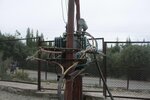T
treez
Guest

Hi,
Supposing we want to put streetlights (40 x 40W units, each 30 metres apart) into a third world country.
We have to use aluminium overhead wiring, as copper gets stolen, and is too expensive.
It is powered from a local 240VAC generator, dedicated to this task.
Can i just use the single live wire to send along to the units in a daisy chain, and then connect each lamp neutral to the streetlight pole, which is obviously buried into the ground at its base...then i connect the neutral at the generator to the earth at the generator via an earthing rod.
(this is to save money on a neutral conductor)
Can this be done?
Supposing we want to put streetlights (40 x 40W units, each 30 metres apart) into a third world country.
We have to use aluminium overhead wiring, as copper gets stolen, and is too expensive.
It is powered from a local 240VAC generator, dedicated to this task.
Can i just use the single live wire to send along to the units in a daisy chain, and then connect each lamp neutral to the streetlight pole, which is obviously buried into the ground at its base...then i connect the neutral at the generator to the earth at the generator via an earthing rod.
(this is to save money on a neutral conductor)
Can this be done?




